Dixie State University Library & Learning Services
Annual Report 2019–2020
2018–2021 Strategic Directions
Mission Statement
Dixie State University Library & Learning Services, including the Library, Special Collections & Archives, the Writing Center, and the Academic Performance Centers, provides the resources necessary to facilitate research and enhance the curriculum and programs of Dixie State University. Library & Learning Services delivers innovative services and opportunities, both of which promote and support learning and intellectual engagement for students, faculty, staff, and community.
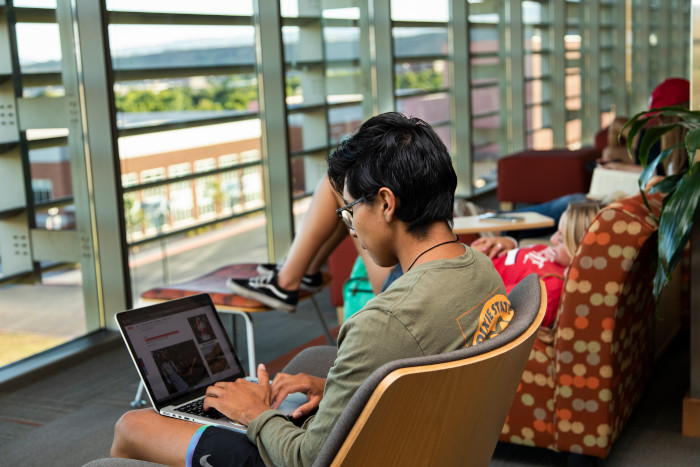
Values
Library & Learning Services is committed to…
- Access
- Service
- Life-long learning
- Intellectual and academic freedom
- Collaboration
Vision Statement
Dixie State University Library & Learning Services is central to the learning environment of DSU and is a welcoming destination for the discovery and creation of knowledge both physically and online. We will excel in offering expert guidance, valuable resources, and state of the art technologies. We will enhance student’s learning and will foster a welcoming atmosphere that encourages diversity, exploration, positive learning, and personal development.
2018–2020 Priorities and Key Strategic Initiatives
| Priority | Selected Tasks |
|---|---|
| 1. Embed information literacy into the curriculum |
|
| 2. Expand resources and enhance services |
|
| 3. Contribute to campus-wide retention efforts |
|
| 4. Remove Barriers to Access and Improve Efficiencies |
|
Goals & Accomplishments
The following program summaries are based on the goals and objectives identified in the strategic plan and assessment plan and encompass those identified in last year’s annual report. The full annual reports for each department (including department and program SWOT analyses) can be found on our website https://library.dixie.edu/info/mission_and_planning.html
LLS Goal 1: Embed Information Literacy into the curriculum
Instruction Program
Strategy: Participate in GE assessments for critical thinking and information literacy.
Results: Information literacy was assessed by the General Education (GE) Committee for an integrated assignment in GE biology courses. An assessment plan will be developed based on lack of information literacy instruction in many of the courses to compare those who did not to those classes who did have instruction. Information literacy integration in English curriculum will be assessed by the GE committee in coming years.
LLS Goal 2: Expand Resources and Enhance Services
Instruction Program
Strategy: Explore expanded programs and classes through L&LS.
Results: Unfortunately, the program proposal for a certificate or AAS degree in library science was not approved.
Administration
Strategy: Create a Friends of the Library group for outreach and fundraising.
Results: Discussions around a creation of a Friends of the Library have continued the past year. Several people were discussed/identified as potential people who could help begin the Friends group. Roadblocks were unearthed when discussion around finances with the business office revealed that auditing of the group would need to be arranged which would be a significant financial burden. Discussions are still happening but have been delayed due to the focus in the COVID-19 pandemic.
Strategy: Continue to pursue Patent & Trademark Resource Center designation and explore options for certificate in Intellectual Property.
Results: The PTRC designation continued to be pursued. However, due to federal hiring freezes and budget issues, new PTRC designations have been halted. Communications with PTRC contacts and monitoring of the status will continue.
Technical Services Program and Administration
Strategy: Increase library materials budgets.
Results: Some progress has been made towards this goal. The library received variable ongoing operating budget increases in a new account for Graduate Funding of $2158 for the Marriage and Family graduate degree, and $1025 for the Technical Writing graduate degree. John Burns, our Electronic Database librarian, has negotiated with UALC to get access this last year to 59 Gale electronic databases for under $1800.
Learning Services
Strategy: Begin a proposal to acquire a Title III SIP grant.
Results: We completed our desired outcome of beginning the grant proposal by making a process plan, recruiting committee members and forming a committee, gathering data, and beginning the writing process.
Strategy: Additional CRLA certification
Results: We completed our desired outcome of marketing CRLA certification across campus and acquiring certification for the Peer Coaching program and Supplemental Instruction program.
Strategy: Increase total student visits this academic year.
Results: We more than accomplished our desired outcome of a 10-percent increase for both the Writing Center and APC. Our total consultations for 2019–2020 in the APC were 12,696, up from 7,511 visits the previous year, which is a 69 percent increase; however, we were on track for 15,625 appointments before the transition to remote learning. This would have put us at a 108 percent increase over 2018–2019. Our total consultations for 2019–2020 in the Writing Center were 3,137, down slightly from 3,194 visits the previous year; however, we were on track for 3,800 appointments before the transition to remote learning. This would have put us at a 19 percent increase over 2018-2019. We accomplished this goal for the two centers through two strategies. (1) We hired a marketing intern to increase awareness of the Writing Center and APC. Some of her marketing strategies included emails, A-frame signs, Trailtracker newsletter, flyers, Canvas announcements, among others. We held an open house the first week of fall semester and invited all faculty and staff to attend. Although we had fewer than 100 attendees, those who did attend got a first-hand look at our learning centers and our strategies for success.
Strategy: Increase subject and departmental tutoring.
Results: We completed our desired outcome of adding two more tutors to our APC staff for 2019–2020, and we added tutoring in some biology and chemistry courses, accounting, economics, and business statistics. We completed our desired outcome of adding two departmental tutors in the Writing Center for students writing ACS style and those studying exercise science.
Special Collections & Archives Program
Strategy: Build digital collections infrastructure.
Results: A great deal of progress has been made, with a few steps left to complete. A committee formed to investigate paid subscription and open source digital asset management systems (DAMS). A decision was made to continue building out an existing Omeka site and utilize the Oral History Metadata Synchronizer (OHMS) in connection with Omeka. The Omeka site is ready for materials to be ingested, but there is still work to do in getting Omeka and OHMS to work together.
Strategy: Guide development of open educational resources on campus.
Results: OER on campus has mostly stalled as a campus wide initiative. A team from DXL, CTL and the library received an internal Atwood Retention Grant to promote the use of OER on campus. The group decided to offer mini grants to faculty for implementing OER in a high enrollment course. No viable courses could be identified. The faculty interested in converting to OER either did not teach high enrollment courses or there was no consensus across the course on how it should be taught. Some progress was made by an intern hired under the Atwood grant to develop a webpage, explaining OER, https://oer.dixie.edu/. Individual faculty occasionally reached out to the librarian over OER asking for help with OER. Many of those requests originated from the Online Teacher Certification course for faculty. The librarian did several sessions with faculty searching for appropriate OER resources for their classes, but to the librarian’s knowledge no faculty adopted OER as a result.
LLS Goal 3: Contribute to campus-wide retention efforts
Department Wide
Strategy: Participate in FYE - Trailblazer Connections.
Results: Departments contributed to this effort in many ways including faculty serving as instructors, creating materials, and conducting workshops. The library workshops were redesigned based on feedback from the previous year.
Learning Services
Strategy: Improve student grades and retention with SI program.
Results: We attained our desired outcome of improving student grades and retention numbers by five percent from fall 2019 to spring 2020. Students who attended eleven or more weekly SI sessions during fall semester were retained at a much higher rate than those attending fewer sessions (86% vs 50%). Students who attended eleven or more weekly SI sessions during fall semester scored much higher grades than those attending fewer sessions (3.10 average vs 2.13).
Strategy: Improve student grades and retention with SI program.
Results: We attained our desired outcome of implementing the CircleIn app; however, we did not attain our desired outcome of increasing student success in CircleIn integrated courses. CircleIn has given us a contract extension for one more year, so this goal will be ongoing.
Strategy: Create a study to show that tutoring of biology students correlated with higher student success.
Results: We attained our desired outcome of correlating Academic Performance Center visits with student success in anatomy and physiology classes. Students in BIOL 2320 classes (anatomy) were incentivized to work with tutors in the APC. In those study courses, the average final grade was 3.02 compared with a 2.61 average for control classes that did not have their students visit the APC. Students in BIOL 2420 classes (Physiology) were incentivized to work with tutors in the APC. In those study courses, the average final grade was 3.44 compared with a 2.76 average for control classes that did not have their students visit the APC.
Strategy: Create a study to show that mandatory Writing Center tutoring in English 1010 and 1010D is effective in aiding students writing proficiency.
Results: We attained our desired outcome of correlating Writing Center visits with student essay score and final grade improvement. Students who took their essays to the Writing Center for help received an average essay grade of 2.94 (roughly a B) compared to an average grade of 1.60 (C-) for those who did not. Students who took their essays to the Writing Center for help received an average course grade of 3.25 (roughly a B+) compared to 2.18 (C+) for those who did not.
LLS Goal 4: Remove Barriers to Access and Improve Efficiencies
Technical Services Program
Strategy: Re-evaluate, document and revise internal policies, procedures, and guidelines
Results: Technical Services continued the revision of processing policies. Several other policies, procedures and guidelines for acquisitions, processing, cataloging, access, work in the bindery, and the annual inventory process continue to be re-evaluated, documented and revised.
Strategy: Redesign web pages for user experience.
Results: All pages are now fully mobile friendly. Aspects of the web experience are being evaluated using Google Lighthouse to identify metrics for improvement.
Strategy: Assess accessibility of library resources and determine a baseline.
Results: The Web Content Accessibility Guidelines (WCAG) 2.1 were identified as the appropriate guidelines for measuring web accessibility. Microsoft’s Accessibility Insights for Web was identified as an appropriate testing suite for measuring WCAG 2.1 compliance. The library’s webpages were benchmarked and improvements noted. Work has now begun in implementing those improvements which will be measured as improved pass performance in the testing suite.
Special Collections & Archives Program
Strategy: Re-evaluate and revise internal policies, procedures, and guidelines.
Results: In addition to work completed and reported in last year's report, DSU policy 608: Library Special Collections & Archives Reproduction, Use License, and Research Requests was approved by the Board of Trustees and became an official policy in Spring 2020. The oral history procedures were evaluated and revised in response to DSU Special Collections & Archives taking on work that had previously been managed by a volunteer. More details are available under Department Highlights—Oral Histories.
Strategy: Integrate all archival access points into the archive management system (ArchivesSpace).
Results: This goal is a multi-year project, and the first stages have been completed. Last year, it was reported that all materials in the vault were given an accession number and description in ArchivesSpace. This year the boxes in processed collections were given barcodes. The barcode and shelf location of the boxes were entered into ArchivesSpace. This means that now each box can be found using a unique identifier number. Since this change, researchers have sent requests for boxes using the number, which gives staff the location of where the box resides quickly and easily. The process of adding barcodes to boxes and other containers has started on accessions, which is a larger portion of the collection and will take more time to complete.
Strategy: Provide a secure location for Reading Room users to place personal belongings.
Results: This goal is feasible, but was not accomplished. Developing documentation of the need has to be done at random times when researchers are utilizing the reading room, which was difficult to do. It is a necessary change and will continue as a goal for next year.
Strategy: Redesign Special Collections website to be more user friendly and have ArchivesSpace more prominently featured as a resource.
Results: The entire library website is undergoing a redesign. Some easy changes to the Special Collections section of the website were enacted before the full redesign with more to come in the full redesign. The largest change was removing the Special Collections landing page, and instead using a second layer menu on the library main page to resemble the rest of the library website. An oral history search box was added to the menu, which greatly facilitates the search of oral histories and removes several steps. A library wide change in chat providers allowed an Ask an Archivist chat box to be added to the Special Collections & Archives pages. It was used within one day after launch by a researcher and there has been steady but slow use since.
Learning Services
Strategy: Create SI mission statement and PLOs.
Results: We attained our desired outcome of creating a mission statement and PLOs for the SI program. Our program learning outcomes are the following:
- Students will be able to utilize what they have learned and skills they have acquired through SI to increase success in all their courses.
- Students will demonstrate increased confidence in their ability to meet all course objectives and learn independently.
- Students will learn and apply improved study habits and time management skills.
Strategy: Increase Writing Center and APC department efficiency.
Results: We attained our desired outcome of making the Writing Center & Academic Performance Center more efficient by adjusting our tutoring hours. We lowered our number of tutors at certain times of the day and increased numbers at other times to better match student demand. We created an ongoing training program for tutors in the Writing Center to brush-up on their skills. We will implement these Canvas modules next fall.
Administration
Strategy: Re-evaluate, document and revise internal policies, procedures, and guidelines.
Results: Complete review, editing, and approval of all major public-facing and internal guidelines and procedures were completed this year.
Strategy: Implement reservation system for study rooms.
Results: A reservation system for ten study rooms was implemented during the Fall 2019 semester. The reservations have been popular with the rooms being booked a total of 1,667 times during the academic year when the study rooms were available.
Strategy: Enhance ILS with customizations to improve functionality.
Results:
- Is this goal being carried over from the previous year? no
- Action Plan: Library IT systems will meet with library faculty staff for recommendations on functionality desired and present recommendations on feasibility.
- Desired Outcome: A more user friendly, modern library catalog.
- Timeline: Fall 2020, priorities established. Spring 2020 updates made.
- How does this goal align with departmental and instructional goals? LLS Goal 4: Remove barriers to access and improve efficiencies.
- What resources will be needed? Library systems personnel time.
Public Services
Strategy: Implement new circulation procedures; including extended checkout periods, and simplified replacement process.
Results: Term long checkouts have been implemented. This has been very helpful in eliminating barriers to student borrowing. This has also slightly improved staff workflow by not spending large amounts of time on very small fines. Patrons generally like the new system, but are confused about the “grace period”. This will be addressed with the new ILS system upgrade.
Strategy: Re-evaluate and revise internal policies, procedures and guidelines.
Results: Extensive review of all internal circulation, fines, lending and other internal policies were revised to reflect current practices. Based on faculty feedback, the limit on the number of items checked out was raised for both faculty and students.
Department Faculty and Staff Highlights
David Zielke: He served on the DSU Rank, Tenure and Promotion Intermediate Review Sub-Committee Chair for 2019–2020. He served on at least one hiring committee as the Diversity Advocate. He was the chair of the hiring committee for the technical services paraprofessional position that came open after a staff member resigned in November 2019.
Andrea Smerud: She created a system for students to be aware of online periodicals. She served on the technical services paraprofessional hiring committee. She updated procedures and implemented a system to track gift donations. She created a spreadsheet to track incoming and discontinued periodicals. She completed Gobi training for online ordering, and streamlined the ordering process. She reorganized and relocated billing binders for easier access.
Kathleen Broeder: Co-authored a paper with Emma Lanners published “Priming for Advocacy: Revitalizing A 35-Year-Old Lecture Series,” in Marketing Libraries Journal, a peer reviewed journal in Spring 2020. Kathleen and Dianne Aldrich are in the process of writing a book for the Images of America series on St. George, Utah using images from Special Collections & Archives. Kathleen was accepted to co-present at Utah Library Association Conference and at the Teaching & Learning Conference with Dianne, but both were canceled due to COVID-19. Kathleen served on the Women’s Resource Committee, IRB Committee, Policy Steering Committee, DHU5 Conference planning group, and both committees of the Juanita Brooks Lecture Series. She also serves as vice-president of the Washington County Historical Society (WCHS) and as an advisory board member to the Daughters of Utah Pioneers McQuarrie Museum Board.
Tammy Gentry: She has been featured in the Library and Learning Services newsletter under the Employee Spotlight and an article about a Special Collections rare bible. She has served on a hiring committee and participated in a two-day Regional Heritage Stewardship Program Workshop, the QPR Suicide Prevention training, Dixie Development Day, and multiple on campus trainings.
Tracey O’Kelly: Has been actively developing her professional development with Oral History Association conference attendance, QPR Suicide Prevention training, and individual readings on cataloging, local history, and time management. She is also committed to service. She has served on three hiring committees and an athletics committee to determine if scholarships can fund books.
Dianne Aldrich: Appointed by the governor to the Library Board for the State of Utah.
Ellen Bonadurer: Started an initiative in Public Services for everyone to create a desk manual to help with cross training or temporary staffing if needed.
Denali Lathrop: Completely overhauled the reserve collection and organized it so that the student workers can easily find materials that are requested.
John Burns: Member and former chapter chair of the regional chapter of ARLIS/NA (Mountain West). He serves on the DSU Undergraduate Research Committee and chairs the Dixie Forum committee. He serves as a diversity advocate on search committees and is a member of the UALC collection development committee and DOCUTAH.
Emma Lanners: Graduated with her Masters in Library & Information Science. She co-authored a paper with Kathleen Broeder published “Priming for Advocacy: Revitalizing A 35-Year-Old Lecture Series,” in Marketing Libraries Journal, a peer reviewed journal in Spring 2020. Emma was also accepted to co-present at Utah Library Association Conference with Kathleen, but was canceled due to COVID-19 safety measures.
Rob Gray: Applied for and received CRLA program certification for the Academic Performance Center, the Writing Center, the Peer Coaching program, and the Supplemental Instruction program. He is heading a committee to pursue a Title III SIP grant for five-year funding for supplemental instruction, expanded tutoring, and first-year experience. He co-wrote an article on mandatory tutoring that was published in Curiosity, DSU’s online research journal.
Adam Russel: Was our SI coordinator until the end of Spring Semester. He graduated with a degree in biology and is in the process of applying for medical school.
Hailey Faiola: Hailey received her AA degree in the fall and was accepted into DSU’s ELED program.
Catarina Prisbrey: Acted as our marketing coordinator for learning services. She graduated last fall with a marketing degree from DSU and has obtained employment with Wilson Electric as their marketing director.
Brittany Bennett: Was the previous Writing Center coordinator through the end of spring semester. She graduated with a degree in history and a minor in English. She wrote articles for the 2019 DSU Annual Academic Report.
Ashton Corsetti: Moved to Writing Center coordinator after spring semester. He is an English major with a Professional and Technical Writing emphasis. He worked as an editor of Curiosity, DSU’s online research journal, and had an article published in last year’s edition.
| Name and Degree | Tenure Status
T = Tenured TT = Tenure Track NTT = Non Tenure Track |
Rank | Faculty FTE | Released Time in Credit Hours |
|---|---|---|---|---|
| Dianne Aldrich, MSLIS | T | Librarian | 1 | n/a |
| Caleb Ames, MSIS | T | Associate Librarian | 1 | n/a |
| Kathleen Broeder, MA, MSIS | TT | Assistant Librarian | 1 | n/a |
| John Burns, MLIS | T | Associate Librarian | 1 | n/a |
| Linda Jones, MA, MLIS | T | Librarian | 1 | n/a |
| David Zielke, MLIS | T | Librarian | 1 | n/a |
| Rob Gray, MFA | NTT | Director | 1 | n/a |
Adjunct Information:
- Number of part-time instructors that taught in fall 2019: 0, spring 2020: 0
- Number of credit hours taught by part-time instructors fall 2019: 0, spring 2020: 0
Department Effectiveness
Technical Services
Despite Covid-19 work from home during March through June, Technical Services was able to process several e-book orders through Gobi, so that more online library materials would become available during the pandemic. Technical Services was able to be scheduled with work study students to help with the processing of materials this year. Their tasks included sorting, searching for duplicates in stacks, packaging and labeling.
Cataloging continued during the entire year, because both Linda Jones and David Zielke, the two main catalogers at the library, volunteered to cover the DSU mandatory opening of the DSU Library Computer Area located on the second floor from mid March 2020 through the end of May 2020.
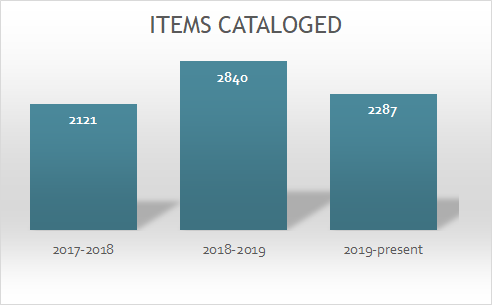
The library’s web page continue to be updated, and are being benchmarked for accessibility using the Web Content Accessibility Guidelines (WCAG) 2.1 and then updated to improve their conformance with those guidelines. The library home page, for example, has gone from an 85% pass rate using a standardized test suite to a 99% pass rate. This improved performance reflects a page that is more accessible to users who rely on keyboard navigation, have color vision deficiencies, or use assistive technologies to overcome visual impairments. Going forward, all library drafted web pages will meet a 99% pass rate.
Eva Sanchez completed an inventory of the physical library materials collection except for Microforms and Special Collections, due to COVID-19 and the Special Collections shelving breakdown during inventory. Several disc videos and other items were identified as missing last year with a value of approximately $3000 and these items were replaced and/or discarded this year.
Public Services
Use of library collections is nearly the same as the 2018–19 year, which was unexpected with the library having limited services through the Covid-19 pandemic. With a total of 13,873 circulated items, this includes print, electronic, and computer checkouts to students, faculty and staff. In particular, our physical collection use is very robust. This demonstrates the deep collaborations our subject liaison librarians have with faculty that results in highly relevant collection purchases.
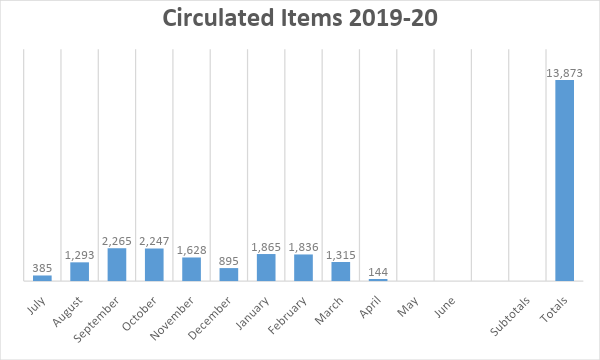
Interlibrary loan borrowing continues to be heavily used with 1334 loans received for our patrons, but only 588 items were provided to other libraries. This reduction can be explained by the lack of lending during the Covid-19 Pandemic. The increased borrowing is explained by students requesting more materials during the fall semester. Since interlibrary loan is a cooperative arrangement between libraries, we make every attempt to loan items to other libraries to help bring our lending and borrowing numbers to a more equal level.
Special Collections & Archives
The backlog of copy catalog books and periodicals have been completely processed and added to the catalog. Donations about the John Birch Society, an ultra-conservative group active in the 1940–50s in St George were processed, and donations of FLDS materials were also received that are near impossible to find or purchase.
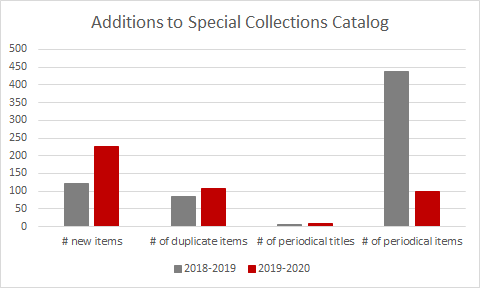
In total, three archival collections have been completed and another 11 collections have had materials added. Special Collections & Archives received a Utah State Historical Records Advisory Board in-kind grant for $1,777 for the purchase of oversized boxes and folders to house the maps and survey drawings in the Leo Alva Snow Collection.
There are several noteworthy improvements in digital collections this year. A library committee recommended Omeka as the most appropriate digital collections platform for DSU use. Oral histories have been selected as the test project and the first major upload project.
We partnered with Ancestry to digitize all student newspapers at no expense to DSU and made searchable in newspapers.com. This was a major undertaking that would not have been possible on our own.
A long-time volunteer has completely retired from managing the oral history process this year. The entire workflow has been revamped to reflect best practices, advances in technology, and streamlining functions. Nine oral histories were transcribed, 22 were cataloged, with 18 new titles, and 400 were used by researchers this year. Twelve total new oral histories were added to the collection, including 10 new recordings with fundamentalist Mormons and 2 donations.
The Reading Room closed on March 16th to on-site visitors due to COVID-19. When Utah moved to a low risk status in June, the Reading Room opened to one researcher at a time by appointment only. The closure has significantly impacted the number of researchers utilizing Special Collections & Archives in March, April, and May (see Research Visits by Month chart). It is expected to affect future use as well.
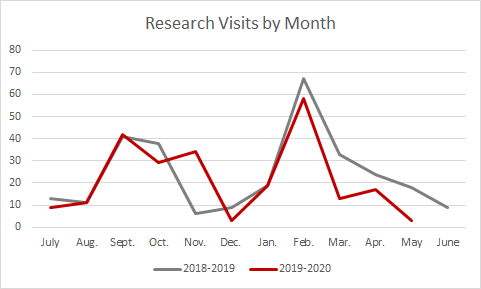
This year (July 1–May 15) we had 238 total visits, a drop from the previous year (July 1–June 30), in both first and returning researchers (see Researchers Visiting the Reading Room chart).
Students fulfilling class assignments are again the main driver behind researchers coming into the Reading Room. There has been a drastic drop in people coming in for family or local history research due to the COVID-19 closure (see Purpose of Research chart). Oral Histories continue to be the highest used type of material (see Types of Materials Consulted chart).
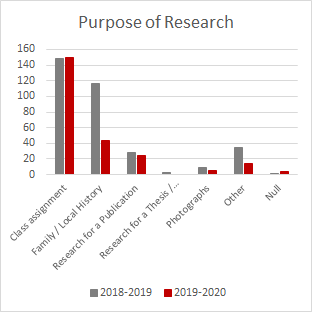
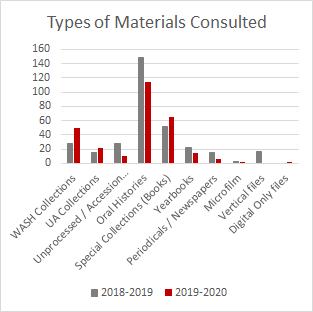
Several professors who have never brought their classes into Special Collections did so this year. Dr. Heather Sinclair brought in a history topics class to find archival material on maternity and midwifery. Dr. Olga Pilkington brought in her History and Structure of the English Language class to look for words that could be submitted to the Oxford English Dictionary (see photographs below).
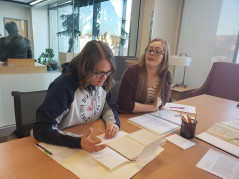
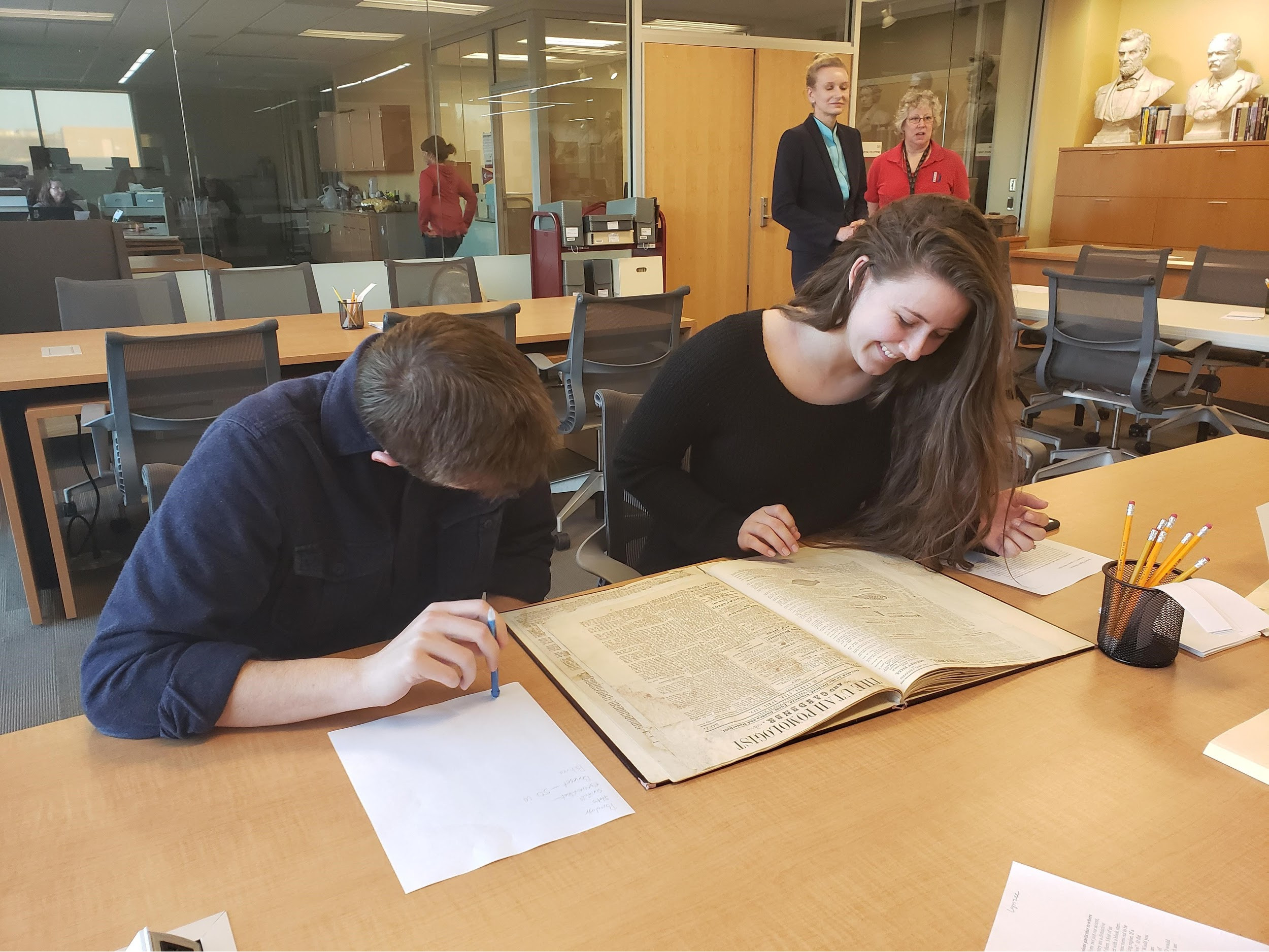
Dr. Leo Lyman used materials in our collection to write his most recent book, Finally Statehood! Utah’s Struggles, 1849–1896. A master’s student from Arizona State University was unable to find sources for her history paper until she came to Special Collections & Archives. Jeffery Holland’s assistant reached out to Special Collections & Archives for information and images that documented his time at Dixie. Special Collections staff researched to help provide the ‘then and now’ images for Spring 2020 issue of DSU Magazine. Three researchers came in together several times looking for oral histories documenting FLDS life for a podcast.
Supplemental Instruction
During the 2019 Fall Semester, the Supplemental Instruction program served over 400 students.
Students who attended at least eleven of sixteen weekly SI sessions scored higher grades (3.10 vs 2.13) and were retained at a much higher rate (86% fall to spring vs 50%) than those who attended fewer sessions (see graph below).
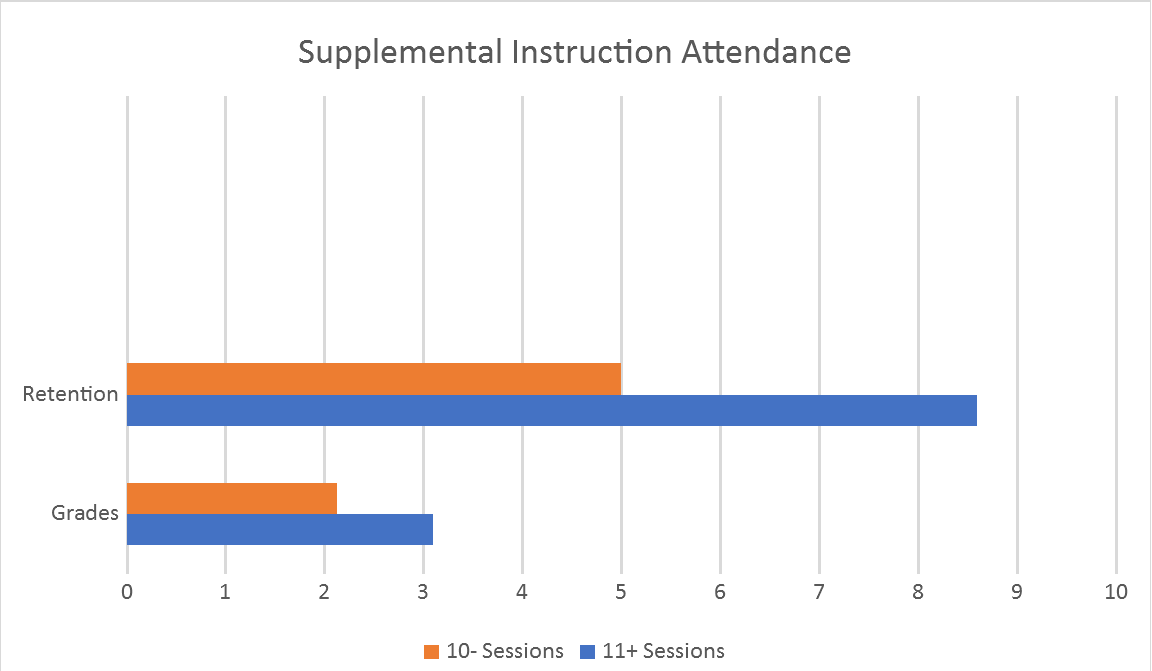
When we excluded the non-mandatory SI sections that typically had low SI session attendance from our study, we found the following (see table below):
- Students attending SI sessions at a high rate earned excellent grades
- Students attending SI sessions at a high rate were retained at a very high rate
- Students not attending SI sessions consistently scored poor grades
- Students not attending SI sessions consistently were retained at a very low rate
| Times Attended |
Average Grade |
Fall–Spring Retention |
Students |
|---|---|---|---|
| 0 | 0.43 | 0.600 | 5 |
| 1 | 0.00 | 0.500 | 4 |
| 2 | 0.14 | 0.167 | 6 |
| 3 | 0.14 | 0.600 | 5 |
| 4 | 0.00 | 0.000 | 3 |
| 5 | 0.18 | 0.750 | 4 |
| 6 | 0.34 | 0.417 | 12 |
| 7 | 2.16 | 0.800 | 5 |
| 8 | 1.38 | 1.000 | 13 |
| 9 | 1.55 | 0.783 | 23 |
| 10 | 1.94 | 0.773 | 22 |
| 11 | 2.30 | 0.760 | 25 |
| 12 | 3.00 | 0.929 | 28 |
| 13 | 3.43 | 0.875 | 40 |
| 14 | 3.37 | 0.870 | 23 |
The Supplemental Instruction program served over 400 students during Spring Semester 2020. These students received extra support in their courses from SI leaders during the transition to remote learning due to COVID-19.
Academic Performance Center
During the 2019–2020 academic year, the Academic Performance Center had 12,696 student visits, a 69 percent increase in total visits over the 2018–2019 academic year (7,511 visits).
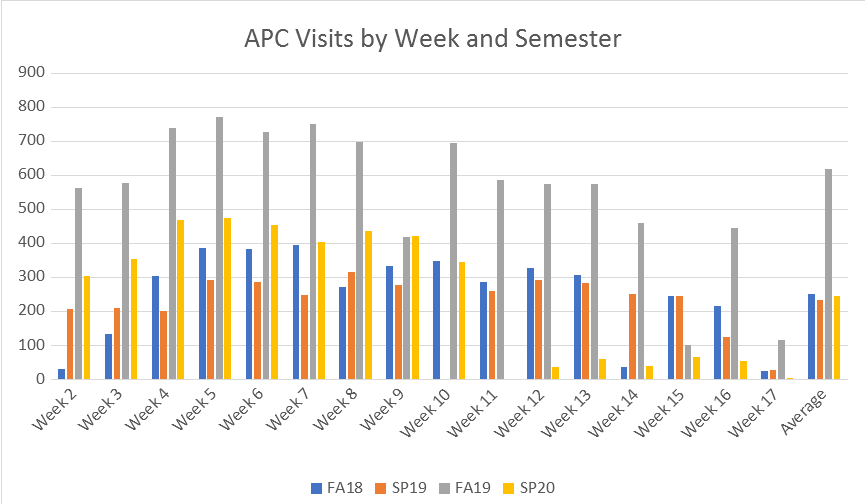
* The Academic Performance Center had fewer visits than expected during weeks 12–17 of spring ’20 due to the transition to remote tutoring because of COVID-19.
Between the 2018–2019 academic year and the 2019-2020 year, the number of synchronous online tutoring sessions that the APC completed increased by 619 percent, from 42 online tutoring sessions to 302.
Last year, we analyzed data from an incentivized tutoring study we conducted with biology classes in the Academic Performance Center. The summary is below.
“I received a database of grades for all DSU classes with students’ names redacted (my request). From the information, I was able to average the grades as follows:
BIOL 2320-04 (study class)- 3.02 average GPA
BIOL 2320-01, 02, and 03 (control classes)- 2.61 average GPA
*I did not use BIOL 2320-05 and 06 in the study as these sections used supplemental instruction as additional tutoring in the classes.BIOL 2420-04 and 50 (study classes)- 3.44 average GPA (combined)
BIOL 2420-01, 02, and 03 (control classes)- 2.76 average GPAI did not use the few pass/no credit grades in the classes toward the GPA.”
In an online survey administered to students on their perceptions of the Academic Performance Center, we found that most students believe that the APC is effective in helping them with their coursework. Between 75 and 88 percent of respondents agree or strongly agree in various areas of student satisfaction (see below).
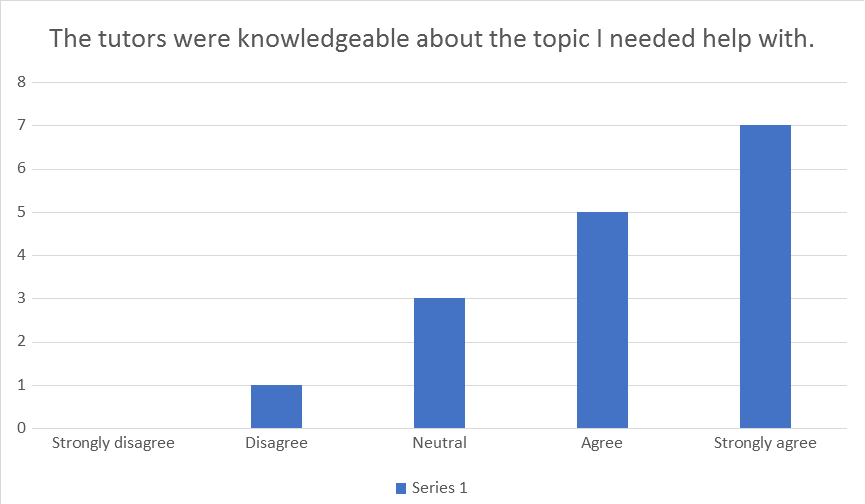
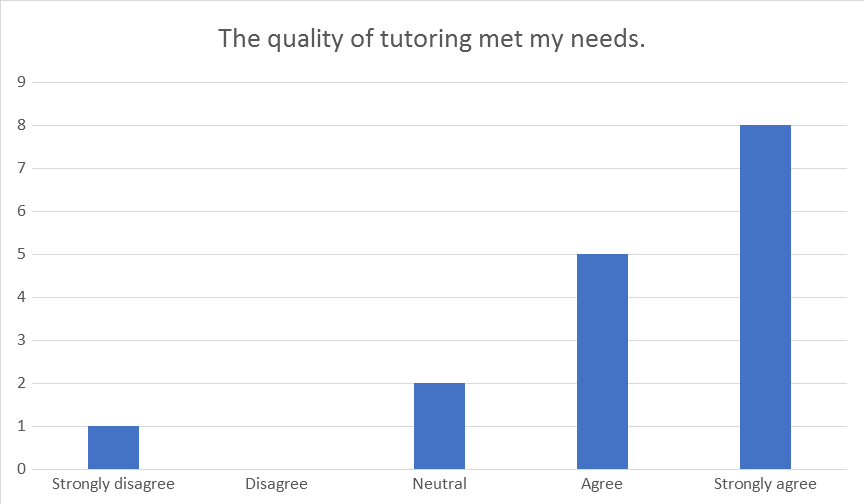

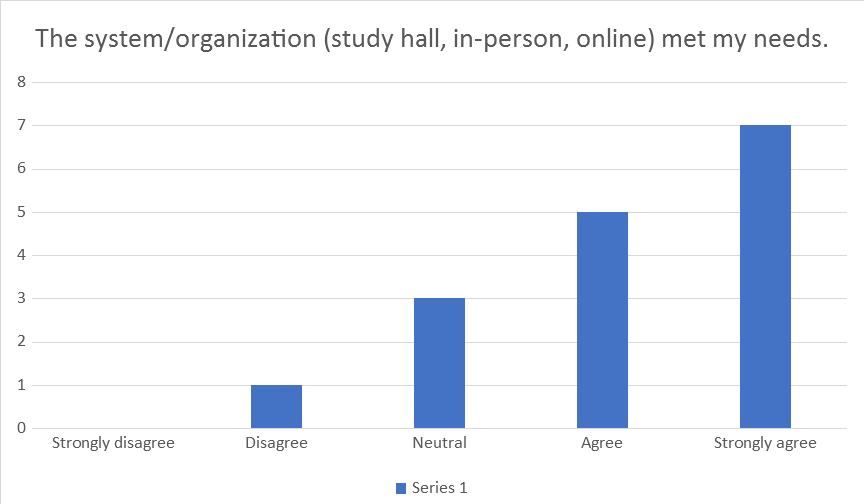
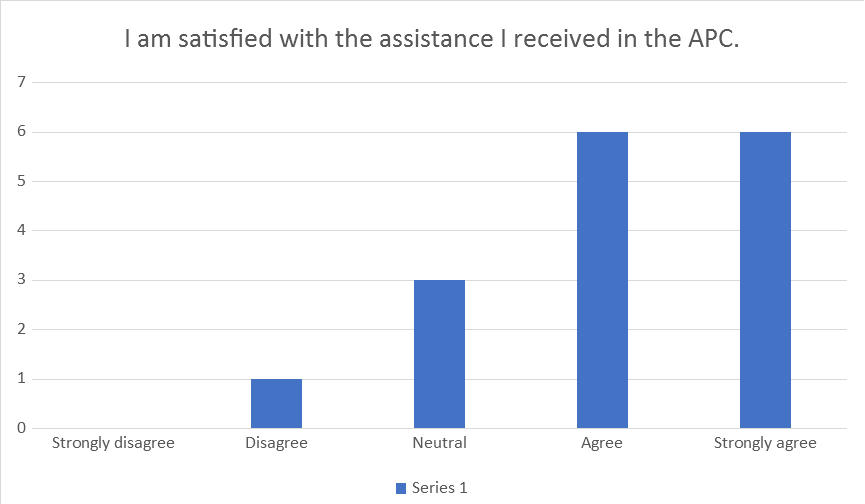
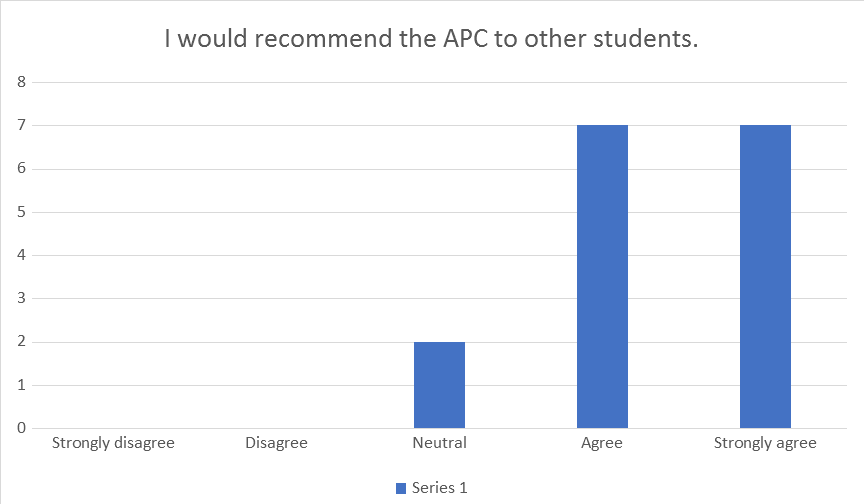
Writing Center
During the fall 2019 semester, the Writing Center completed 1,764 consultations, a 13 percent increase in total consultations over the spring 2019 semester (graph provided below).

The Writing Center was able to add two more department-specific tutors for writing ACS style and those studying exercise science.
Between the 2018–2019 academic year and the 2019–2020 year, the number of specialized tutoring sessions that the Writing Center completed with APA students, primarily psychology, increased by 11 percent, from 399 specialized sessions to 443.
Between the 2018–2019 academic year and the 2019–2020 year, the number of synchronous online tutoring sessions that the Writing Center completed increased by 81 percent, from 344 online tutoring sessions to 622.
Last year, we analyzed data from a mandatory tutoring study we conducted in the Writing Center. The Executive Summary is below.
Mandatory Tutoring: English 1010 Results, Spring 2019
In spring 2019, the Writing Center obtained essay scores and course grades from five instructors and 12 sections of English 1010(D) at the university for 111 new freshmen. Student who did not submit an essay were excluded. In eight sections, it was mandatory for students to attend the writing center for assistance on at least one essay; however, only 60% of new freshmen in these sections took their papers to the writing center. On the other hand, it is important for instructors to do this, because in the four sections without this mandate, none of the new freshmen sought help from the writing center on their papers.
Outcomes were quite different for new freshmen who utilize the writing center compared to those who did not take advantage of the services. The average grade on the essay for those who used the center was 2.94 compared to 1.60 for those who did not; roughly a B compared to failing grades, below a C- on average. The average grade in the course for those who used the center was 3.25 compared to 2.18 for other new freshmen who did not use the writing center.
New freshman who took their papers to the writing center had a higher ACT Composite Score (19) and high school GPA (3.33) than students not taking advantage of services (18 and 3.02). The index score (high school GPA X 10 + ACT Composite) was 48 and 52 respectively, higher for those following their instructor’s guidelines.
One could argue that the difference was due solely to their lack of preparation in high school. To counter this argument, the researchers used a binary logistic regression to predict grades on the essay and grades in the English courses. This was chosen because grades were bimodal; therefore the outcomes were changed to earning a B or higher and C or higher on the essay and for the course grade.
In order to control for differences in high school preparation, the researchers used covariates or control variables in the analyses. Results were similar using different covariates (high school GPA, ACT score or index score). Therefore, the ACT score was chosen because of the larger sample size with this data.
Table 1. Logistic Regression Results (n = 111) Essay Course Grade B or Higher C or Higher B or Higher C or Higher Variables B S. E. B S. E. B S. E. B S. E. ACT Score .132 .069 .110 .068 .165* .072 .071 .080 Utilizing the Center 1.849** .437 1,950** .457 1.898** .476 1.390* .594 Constant -3.633** 1.327 -2.544* 1.280 -3.306* 1.346 -.331 1.447 Correctly Classified 73.0% 68.5% 70.0% 80.0% Nagelkerke R Square .263 .264 .273 .107 *p < .05, **p < .01
When controlling for students’ ACT Composite scores, student compliance with taking their paper to the writing center was associated with earning a B or higher and earning a C or higher on their essay. The same was true for their course grade (all tests statistically significant). Therefore, new freshmen are making a wise choice to utilize tutoring services on campus. The instructor can encourage this by requiring use of the center as part of the course.
In an online survey administered to faculty on their perceptions of the Writing Center, we found that most faculty believe that the Writing Center is effective in helping their students become stronger writers. Between 80 and 90 percent of respondents agree or strongly agree that faculty are satisfied with the tutoring students receive, that faculty are confident in the advice tutors give, that their students are more confident writers after visiting with tutors, and that they would recommend Writing Center services to other faculty members.
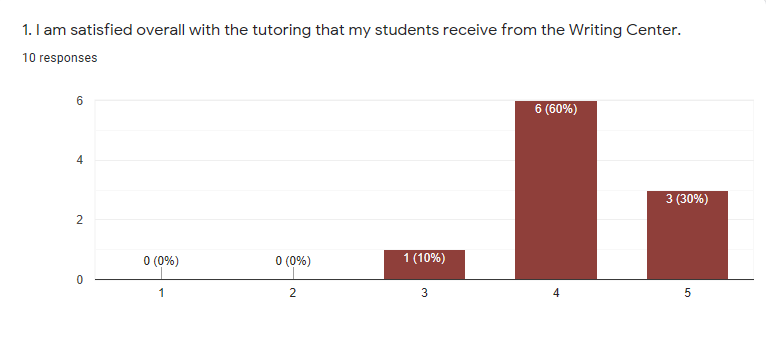
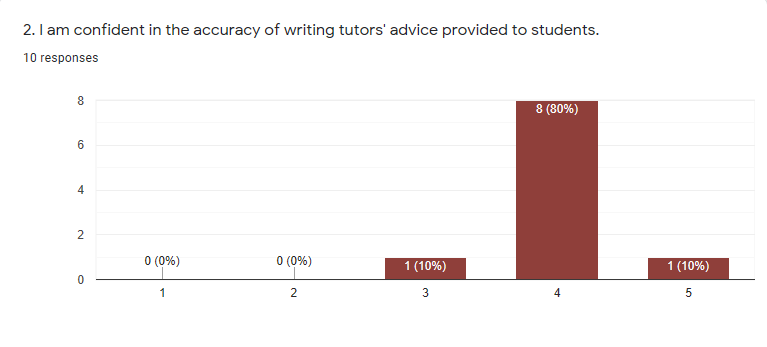

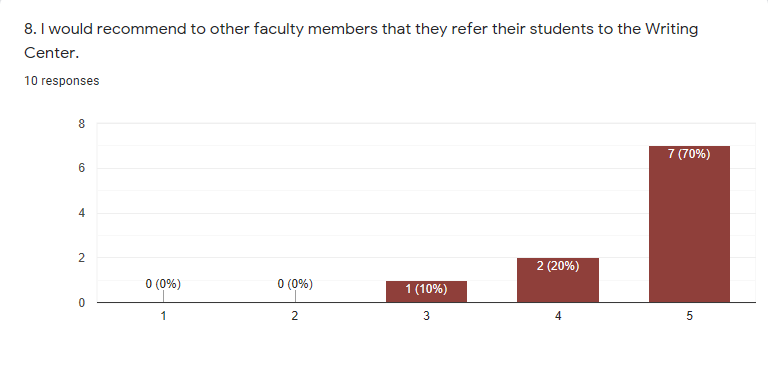
Department Goals 2020–2021
Strategy: Increase total consultations in the Writing Center and APC next academic year
- This goal not being carried over from the previous year.
- Action Plan: Work with our intern to increase social media marketing and other forms including brochures and radio ads. Promote our services to faculty.
- Desired Outcome: Five percent increase in total appointments from last year.
- Timeline: One year
- No additional resources are needed.
Strategy: Increase library materials budgets.
- Is this goal being carried over from the previous year? yes
- Action Plan: Identify all new programs and require identification and purchase of all new library resources needed, including databases, monographs, serials, etc.
- Desired Outcome: Increase ongoing library budgets for library materials. Reduce over-dependence on UALC legislatively funded materials.
- Timeline: Ongoing, for all new and continued DSU academic programs.
- How does this goal align with departmental and instructional goals? LLS Goal 2: Expand resources and enhance services.
- What resources will be needed? Additional funding from DSU to be more comparable with peers.
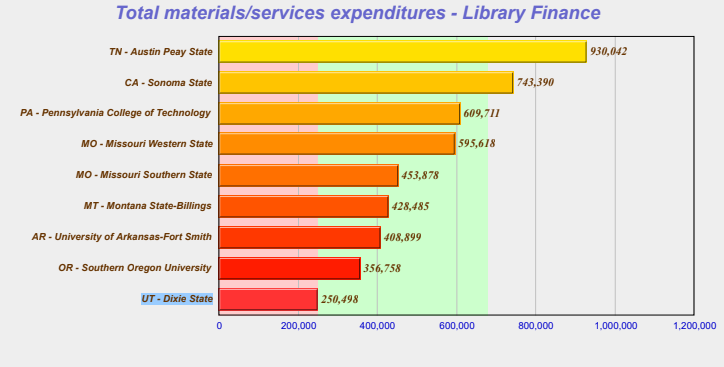
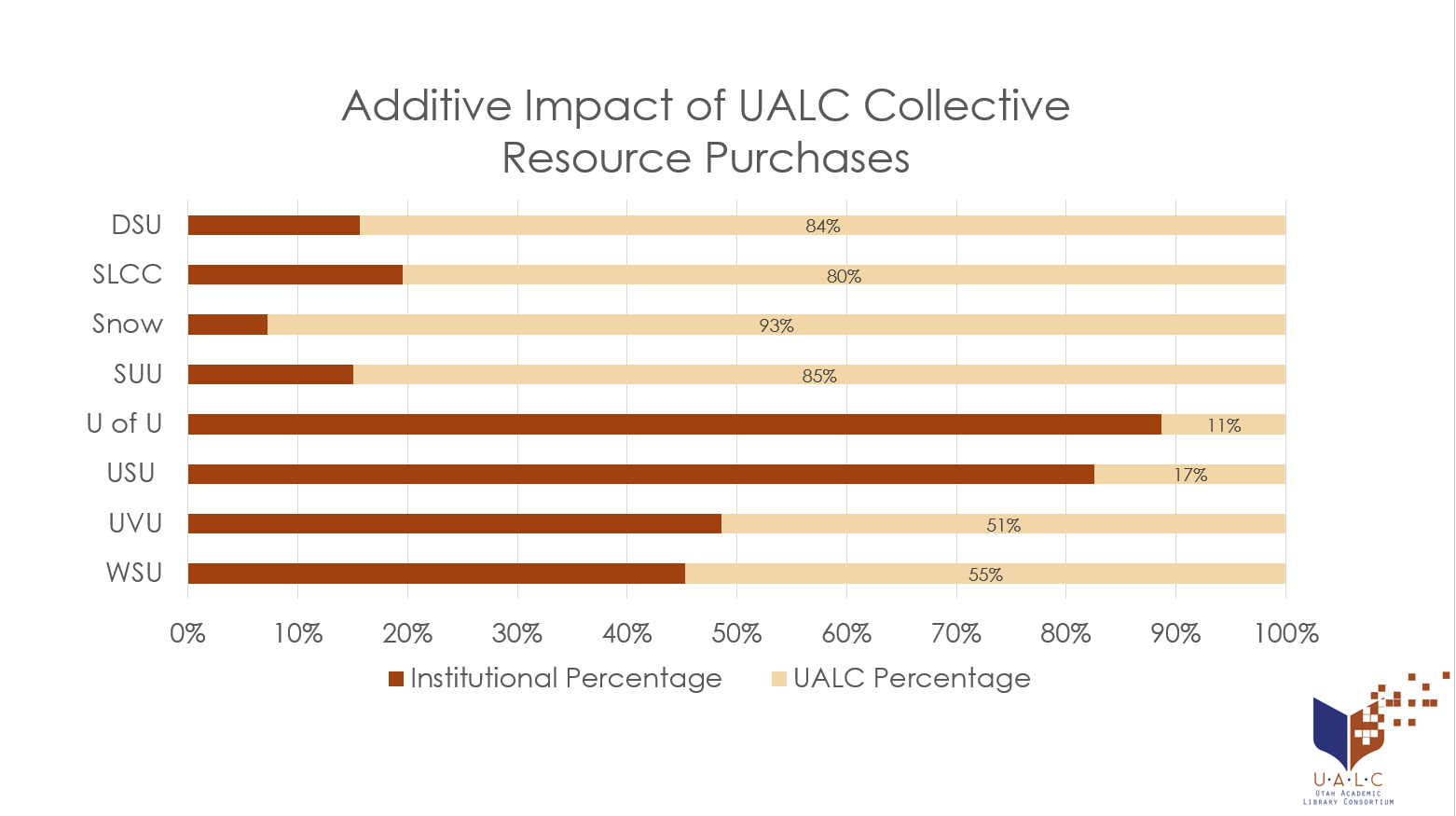
Strategy: Re-evaluate, document and revise internal policies, procedures, and guidelines in Technical Services and Public Services.
- Is this goal being carried over from the previous year? yes
- Action Plan: Continue identifying, re-evaluating, documenting, and revising other internal policies, procedures, and guidelines in Acquisitions, Processing, and Cataloging. With internal policies completed, public services is now working on procedural documentation for each job function within the department.
- Desired Outcome: Have written documentation of said policies and procedures.
- Timeline: By Spring 2021
- How does this goal align with departmental and instructional goals? LLS Goal 4: Remove barriers to access and improve efficiencies.
- What resources will be needed? Staff time
Strategy: Create position of Open Education Librarian to advance OER.
- Is this goal being carried over from the previous year? no
- Action Plan: Create strategy for increasing OER adoption on campus.
- Desired Outcome: Plan created to save students an average of $50 per course because of OER adoption.
- Timeline: Librarian hired Spring 2020, strategy created by Spring 2021 for courses to be offered Fall 2021.
- How does this goal align with departmental and instructional goals? LLS Goal 2: Expand resources and enhance services.
- What resources will be needed? One time funding for a Visiting Assistant Librarian for Open Education & Digital Inclusion.
Strategy: Increase student employment opportunities.
- Is this goal being carried over from the previous year? no
- Action Plan: Work with Career Services to extend student employment in L&LS beyond work study.
- Desired Outcome: L&LS able to offer 15 hours per week of employment to each student employee for the entire school year regardless of work study funding being exhausted. This would keep students employed and improve retention due to students leaving DSU for financial reasons.
- Timeline: Fall 2021
- How does this goal align with departmental and instructional goals? LLS Goal 2: Expand resources and enhance services.
- What resources will be needed? $8500 of ongoing funding to supplement work study funds. This is based on an average work study award of $4000 per student.
Strategy: Implement improvements to the reservation system for study rooms.
- Is this goal being carried over from the previous year? yes
- Action Plan: Figure out how to best organize and control reservation system.
- Desired Outcome: Improve ease of use of system based on student feedback.
- Timeline: Spring 2020
- How does this goal align with departmental and instructional goals? LLS Goal 4: Remove barriers to access and improve efficiencies.
- What resources will be needed? Possibly additional funding for door locks.
Strategy: Redesign web pages for user experience.
- Is this goal being carried over from the previous year? yes
- Action Plan: Update all pages to implement a lightweight, responsive design that improves user experience for a variety of devices and network speeds.
- Desired Outcome: Make library web pages easily accessible to any DSU student or other user.
- Timeline: 2–3 years
- How does this goal align with departmental and instructional goals? Enhancing the services provided to all library patrons
- What resources will be needed? Time for Caleb Ames and others
Strategy: Increase accessibility and discoverability of collections.
- Is this goal being carried over from the previous year? yes
- Desired Outcome: The library will take the results of the MISO survey and make an action plan based on the results. Possible additional surveys will be conducted as needed.
- Timeline: Ongoing
- How does this goal align with departmental and instructional goals? Enhances the services provided to all library patrons, regardless of ability
- What resources will be needed? Time for librarians and others
Strategy: Utilize ACRL Metrics Comparison to peers.
- Action Plan: Use ACRL Metrics to analyze and compare the DSU library to its national peers.
- Desired Outcome: Identify strengths and weaknesses in our library and university in offering sufficient resources for our academic programs and goals.
- Timeline: Ongoing
- How does this goal align with departmental and instructional goals? Remove Barriers to Access and Improve Efficiencies
- What resources will be needed? Staff time
Strategy: Assess accessibility of library resources and determine a baseline.
- Is this goal being carried over from the previous year? no
- Action Plan: Develop guidelines based on the W3C’s Web Accessibility Initiative and the Association of Research Libraries’ best practices and apply them to the DSU library’s online offerings.
- Desired Outcome: Identify practical steps that can be taken to improve access for all the library’s users.
- Timeline: 1–2 years
- How does this goal align with departmental and instructional goals? Remove Barriers to Access and Improve Efficiencies and Enhancing the services provided to all library patrons, regardless of ability.
- What resources will be needed? Time for Caleb Ames
Strategy: Improve accessibility of the library’s web pages.
- Action Plan: Using the Accessibility Insights for Web testing suite that was used to determine the accessibility baseline in TS Goal 2, improve all library drafted webpages to pass 99% or more accessibility tests.
- Desired Outcome: A library web presence that supports visitors of all abilities.
- Timeline: 1–2 years
- How does this goal align with departmental and instructional goals? Remove Barriers to Access and Improve Efficiencies and Enhancing the services provided to all library patrons, regardless of ability
- What resources will be needed? Time for Caleb Ames
Strategy: Develop one library program each semester.
- Is this goal being carried over from the previous year? yes
- Action Plan: Survey library student workers with 3–5 program ideas. Implement the most popular/feasible idea during Spring 2021.
- Timeline: By Spring 2020.
- How does this goal align with departmental and instructional goals? LLS Goal 4: Remove barriers to access and improve efficiencies.
- What resources will be needed? Staff time.
Strategy: Integrate all archival access points into the Archive management system.
- Is this goal being carried over from the previous year? yes
- Action Plan: Place a barcode on each box or container of archival materials. In Archives Space, give each box or container the barcode number, shelf location, and container specifications (box dimensions and other descriptions) in the instances section. Explore the possibility of adding records to Workflows to determine if RFID can be utilized for inventory checks.
- Desired Outcome: Facilitate the ease of access to archival collections by relying on one system to record all data. Once completed this process will eliminate an unwieldy excel spreadsheet used in conjunction with Archives Space. Archives Space can produce a shelf list that can be used for inventory checks. It should be much easier to do inventory control than with the current spreadsheet.
- Timeline: 1–2 years
- How does this goal align with departmental and instructional goals? LLS Goal 4: Remove Barriers to Access and Improve Efficiencies
- What resources will be needed? A well-trained student worker or staff time, and a few basic supplies.
Strategy: Provide a secure location for Special Collections reading room users to place personal belongings.
- Is this goal being carried over from the previous year? yes
- Action Plan: Request lockers from the HCC building committee.
- Desired Outcome: Security of personal belonging and reduced risk of theft from Special Collections & Archives materials for the university.
- Timeline: 1 year
- How does this goal align with departmental and instructional goals? LLS Goal 4: Remove Barriers to Access and Improve Efficiencies
- What resources will be needed? lockers
Strategy: Review and revise Special Collections & Archives mission, vision, and develop a strategic plan for growth in accordance with the forthcoming institution’s 2020 strategic plan.
- Is this goal being carried over from the previous year? no
- Action Plan: For this to be a successful project it will require collaboration between Special Collections & Archives staff to research comparable institutions and compose a draft. The draft proposal will be submitted to the Dean of Library & Learning Services and the Library Advisory Committee for approval.
- Desired Outcome: A more clear direction for growth.
- Timeline: 1–2 years
- How does this goal align with departmental and instructional goals? LLS Goal 4: Remove Barriers to Access and Improve Efficiencies.
- What resources will be needed? Staff time.
Strategy: Write a Title III Strengthening Institutions Grant.
- This goal is being carried over from the previous year.
- Action Plan: Plan and begin writing a retention-based Title III grant to expand the supplemental instruction program.
- Desired Outcome: Acquire an average of $100,000 per year over the next five years for SI.
- Timeline: Two years
- How does this goal align with departmental and instructional goals? LLS Goal 2: Expand resources and enhance services.
- What resources will be needed? No additional resources are needed.
Strategy: Show SI program effectiveness.
- This goal is not being carried over from the previous year.
- Action Plan: Survey faculty to discover their perception of SI leader effectiveness.
- Desired Outcome: Eighty percent of faculty who teach an SI course agree that SI leaders are effective in helping their students.
- Timeline: One year
- How does this goal align with departmental and instructional goals? LLS Goal 2: Expand resources and enhance services.
- What resources will be needed? No additional resources are needed.
Strategy: Show SI program effectiveness.
- This goal is not being carried over from the previous year.
- Action Plan: Survey students to discover their perception of SI program.
- Desired Outcome: Seventy percent of students who agree that SI leaders are effective in helping them achieve a better grade in the class.
- Timeline: One year
- How does this goal align with departmental and instructional goals? LLS Goal 2: Expand resources and enhance services.
- What resources will be needed? No additional resources are needed.
Strategy: Show SI program effectiveness.
- This goal is not being carried over from the previous year.
- Action Plan: Study data to show that students achieve higher grades in SI classes.
- Desired Outcome: Students receive ½ grade higher in SI classes than comparable classes.
- Timeline: One year
- How does this goal align with departmental and instructional goals? LLS Goal 2: Expand resources and enhance services.
- What resources will be needed? No additional resources are needed.
Strategy: Increase tutoring of underserved populations.
- This goal is not being carried over from the previous year.
- Action Plan: Work with the Multicultural Inclusion Center and the Structured Enrollment program to increase at-risk student visits.
- Desired Outcome: Increase minority and structured enrollment student visits by five percent over the previous year.
- Timeline: One year
- How does this goal align with departmental and instructional goals? LLS Goal 2: Expand resources and enhance services.
- What resources will be needed? No additional resources are needed.
Strategy: Show Writing Center and APC Effectiveness.
- This goal is not being carried over from the previous year.
- Action Plan: Survey faculty to discover their perception of tutor effectiveness. Survey students to discover their perception of tutor effectiveness.
- Desired Outcome: Eighty percent of faculty who send students to the APC agree that tutors are effective in helping their students. Eighty percent of students who attend Writing Center sessions agree that tutors are effective in making students more confident, independent writers.
- Timeline: One year
- How does this goal align with departmental and instructional goals? LLS Goal 2: Expand resources and enhance services.
- What resources will be needed? No additional resources are needed.
Projected Needs 3–5 Years
The Library anticipates needing additional library faculty and staff as program offerings increase and desires for OER initiatives and extended hours are noted in the new strategic plan.
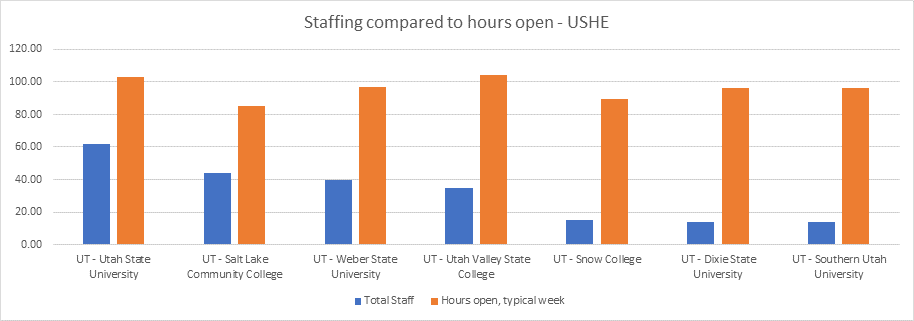
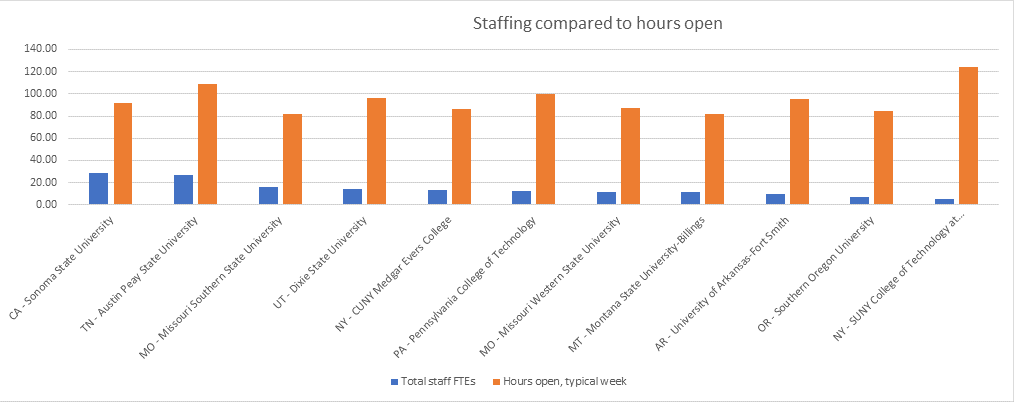
The Supplemental Instruction program’s biggest need in the next few years will be additional funding. We plan to address this with a Title III grant.
For Special Collections & Archives, needs would be maintaining a supply budget consistent with the previous year. Funding an internship would provide an opportunity for active student learning. If Digital Collections are to grow additional staff will be necessary. There is no extra capacity in Special Collections & Archives faculty or staff to take on the extra workload. The position needs to be staff, since it has a high learning curve and student workers cannot be trained adequately to perform the job.
The Academic Performance Center’s and the Writing Center’s biggest need in the next few years will be additional space. As the program continues to grow and as the Athletic Department will require more tutoring to meet Division 1 standards, Learning Services will need additional room. Another need will be additional funding, and we plan to address this with a Title III grant.
Appendix: COVID-19 Response
During DSU’s response to the COVID-19 pandemic, the library second floor remained open for students who did not have access to computers or the internet from home. Book checkout was still available, but all other services moved remotely. Additionally, in collaboration with CSET a laptop lending program was up and running in less than 48 hours. Learning Services made the move to remote tutoring. This graphic outlines more details and statistics of L&LS’s response to the COVID-19 transition.
Additionally, L&LS was able to provide projects for all our student workers to do remotely. In turn keeping them employed until the end of the school year (some tutors are still employed over the Summer) and keeping them safe from exposure.
